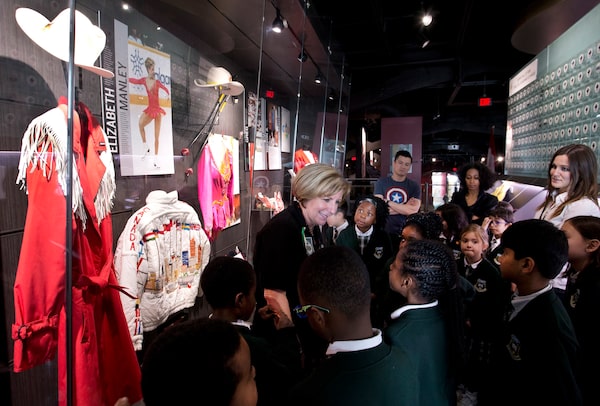
Tour guide Linda Leahy takes a Grade 2 class of students and teachers through various exhibits at Canada's Sports Hall of Fame in Calgary on April 11, 2018.Larry MacDougal/The Canadian Press
The collection of Canada’s Sports Hall of Fame, which has been housed in Calgary for nearly a decade, is moving to the Museum of History in Gatineau.
The Department of Canadian Heritage is funding the total cost of purchasing and preserving the collection. The Museum of History will receive $8.7-million over five years from Canadian Heritage, and $500,000 annually thereafter, to acquire and house the collection.
The Sports Hall of Fame, which is a registered charitable organization, will continue to operate, and its partnership with the museum will still give it access to items in the collection for special exhibits. It will also have access to a digitized version of the collection, a project that the museum is set to complete.
“It’s going to allow the collection to be preserved and digitized, and expanded and shared with more Canadians,” said Cheryl Bernard, the hall’s chief executive officer. “We looked at this as an opportunity to strengthen our digital outreach, and to partner with a large federally owned museum.”
The collection consists of approximately 110,000 artifacts, and features everything from Olympic medals and torches to kayaks and curling rocks. It’s been added to for the past 65 years, and will continue to grow each year when the Hall of Fame welcomes new inductees and their sport paraphernalia.
Ms. Bernard is a curler and former Olympian. She was the skip for Canada’s women’s curling team at the Vancouver 2010 Olympics, where it won silver.
Though the Hall of Fame hasn’t opened for visitors since the start of the pandemic last March, Ms. Bernard said it’s been dealing with low visitor numbers for years.
“There was some great potential, but the location wasn’t drawing sufficient traffic or awareness,” she said. The Hall of Fame building is at Calgary’s Olympic Park, about a 20-minute drive from the city’s downtown. “It’s never really worked. We don’t have public transit up there,” she added.
Housing the artifacts is also very expensive, Ms. Bernard said, citing costs such as humidity control. Additionally, the hall couldn’t digitize the collection on its own budget.
“Now we will continue to build this collection together with the Canadian Museum of History,” she said.
Lobbying information for the Department of Canadian Heritage shows that departmental officials met with representatives from the Hall of Fame 11 times from August, 2020, to April, 2021. Funding was allocated for the purchase of the collection in the spring’s federal budget.
“This rich collection will help our national museum of human history tell the stories of the people, places and events that have shaped, and continue to shape, our country,” reads a statement provided by the Museum of History, released jointly by the Museum and the Hall of Fame. “This partnership will ensure that Canada’s sports history will be accessible to all Canadians now and preserved for future generations.”
The Hall of Fame collection was originally housed for decades in Toronto, and then was in storage beginning in 2004. A few years later, during a period when the Harper government wanted to bring national museums out of Ottawa and across the country, Calgary won a nine-city bid for the new Sports Hall of Fame. A 40,000-square-foot building to house the collection was built on Calgary’s Olympic Park. It officially opened in July, 2011.
Ms. Bernard said it’s too early to know what will happen to the building once the collection has been relocated. Instead of seeing the move as a loss, she said it presents new opportunities for the Hall of Fame to reimagine its impact and reach more Canadians.
“We are transitioning to more of a digital outreach format,” she said, adding that she thinks a lot of museums will have to rethink their approaches because of the pandemic.
Ms. Bernard said money from the sale of the collection will go toward creating digital and educational exhibits, which the hall has already focused on during the pandemic. She said the hall has expanded its virtual educational offerings and has since reached classrooms in B.C., Saskatchewan, Manitoba, Ontario and Nova Scotia, as well as Alberta. Ms. Bernard mentioned an educational initiative that highlights the achievements of Indigenous inductees, and another that focuses on athletes from marginalized populations.
The hall is also looking at temporary exhibits it can show in Calgary, which she said will allow it to bring sports stories to places where people can easily engage with them.
“It was the transition required for the hall,” Ms. Bernard said. “Just being about a building was limiting what we were to this country.”
 Menaka Raman-Wilms
Menaka Raman-Wilms